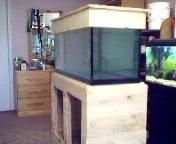Ter
Fishaholic
Hi,
This is my new Tank and Stand I made in the goal creating a reef fish tank... its a 78 gallon(US) Tank, the stand isnt done yes its full of water i'm testing and compacting before i stain & varnish. However before all that I would like to build my own sump. That being said I have a few queries. I'll be using an overflow box already understanding that its not the best way, however I don't trust my glass cutting skills nor do i wanna transport the tank 2 someone who can. anywho ive read around and .. believing ive understood the main idee behind it all, I have one question overflow .2.. swmp.. compartments.. heater... return pump how do i know what to use? if its 2 powerful wont it empty the sump? thats the major part i don't get(so far)
ive understood the main idee behind it all, I have one question overflow .2.. swmp.. compartments.. heater... return pump how do i know what to use? if its 2 powerful wont it empty the sump? thats the major part i don't get(so far) 
Thanks
Terry
This is my new Tank and Stand I made in the goal creating a reef fish tank... its a 78 gallon(US) Tank, the stand isnt done yes its full of water i'm testing and compacting before i stain & varnish. However before all that I would like to build my own sump. That being said I have a few queries. I'll be using an overflow box already understanding that its not the best way, however I don't trust my glass cutting skills nor do i wanna transport the tank 2 someone who can. anywho ive read around and .. believing
 ive understood the main idee behind it all, I have one question overflow .2.. swmp.. compartments.. heater... return pump how do i know what to use? if its 2 powerful wont it empty the sump? thats the major part i don't get(so far)
ive understood the main idee behind it all, I have one question overflow .2.. swmp.. compartments.. heater... return pump how do i know what to use? if its 2 powerful wont it empty the sump? thats the major part i don't get(so far) 
Thanks
Terry




 I thought 3/4" was 600gph and 1" was 1000gph... I was way off
I thought 3/4" was 600gph and 1" was 1000gph... I was way off 